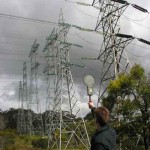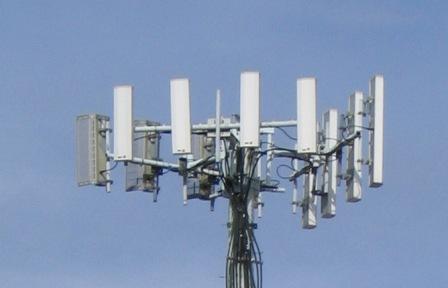
 Measurement of the emissions from a cell tower presents particular technical challenges beyond those encountered for broadcast antenna sites. To understand these challenges, a few comments about radio frequency measurement are required.
Measurement of the emissions from a cell tower presents particular technical challenges beyond those encountered for broadcast antenna sites. To understand these challenges, a few comments about radio frequency measurement are required.
Protocols for the measurement of radio frequency energy for the purpose of human exposure assessment often recommend the use of an “isotropic broadband probe” because this type of sensor responds equally to energy arriving from any direction, and over a broad frequency range, as does the human body. These instruments are commonly used because they permit a quick and simple measurement. Unfortunately, some of the meters used for typical radio frequency compliance surveys are unable to accurately measure the low power densities present at some cell tower sites. An alternate approach is required.
A related problem involves the concurrent presence of other signals besides those from the cell phone system. The “broadband” characteristic of the isotropic broadband probe means that it will measure any signals across a wide range of frequencies. The reading produced by the instrument will be the combination of all signals present. In a large number of cases, the other signals present near a cell tower will be as strong as the cellular signals that one is trying to measure. Realistically, this composite measurement of all signals may be the most relevant exposure metric, but an interpretation of the significance of a reading sometimes requires that one know the frequency of the signal that produced it. For instance, is it FM, TV, cellular, or something else?
One of the most significant radio frequency measurement problems, and one responsible for some of the greatest inaccuracy, involves an instrument erroneous response that can occur when there are two or more strong signals present at the same time. A very large proportion of antenna sites (cell and broadcast) now have multiple strong signals. Instrument design can minimize this problem, but many of the commonly used isotropic broadband meters perform very poorly in this multi-signal environment. The result is a reading that is much higher than actual, sometimes is double (100% error).
An additional challenge results from the fact that power density levels at a cell tower site are not always constant, as they usually are at a broadcast antenna site. People use their cell phones more at some times of the day, and on some days of the week, than at others. The cell phone service providers maintain additional capacity in the form of multiple channels which will become active as needed to meet demand. Each active channel adds to the measured power density at the cell tower site. The variable nature of power density levels at some sites must be taken into account. When necessary, we employ timed signal averaging or data logging to produce an accurate assessment.
Radio frequency measurement surveys conducted by EMF Services employ procedures and equipment to address each of the challenges noted above. A spectrum analyzer is used for identification of radio frequency sources, and for assessment of the relative magnitude of signals in different frequency ranges. The use of this instrument with a calibrated antenna will allow a sensitive and precise “channel power measurement” across selected frequency ranges, or measurement of the strength of an individual signal. In some cases, we also use a high sensitivity isotropic broadband probe for measurement of the composite power density.



